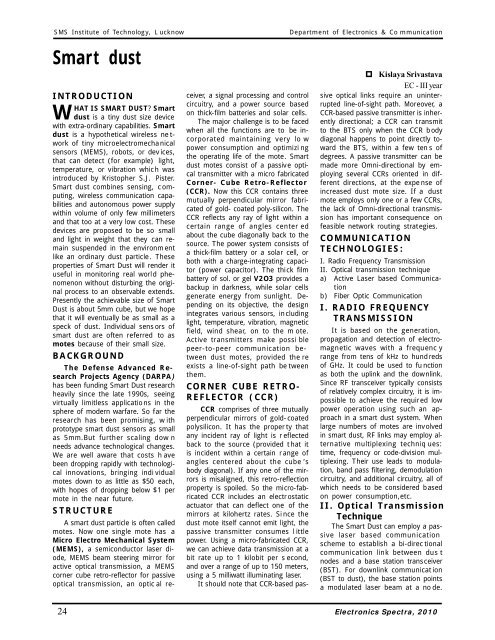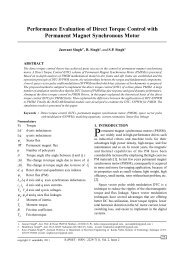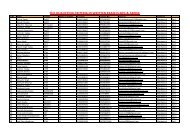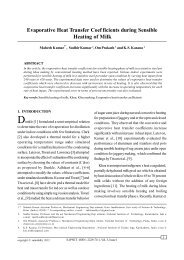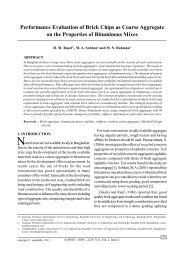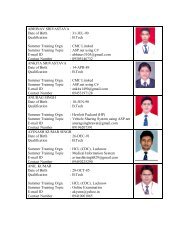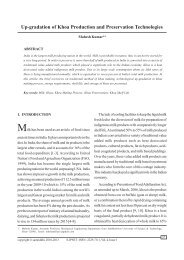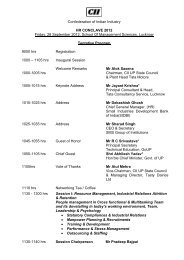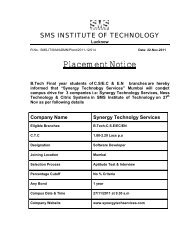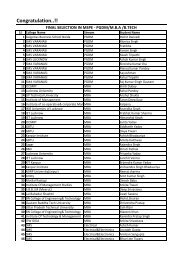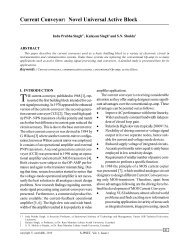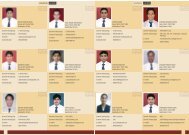Electronics Spectra - SMS Lucknow
Electronics Spectra - SMS Lucknow
Electronics Spectra - SMS Lucknow
Create successful ePaper yourself
Turn your PDF publications into a flip-book with our unique Google optimized e-Paper software.
<strong>SMS</strong> Institute of Technology, L ucknow<br />
Smart dust<br />
INTRODUCTION<br />
WHAT IS SMART DUST? Smart<br />
dust is a tiny dust size device<br />
with extra-ordinary capabilities. Smart<br />
dust is a hypothetical wireless ne t-<br />
work of tiny microelectromechanical<br />
sensors (MEMS), robots, or dev ices,<br />
that can detect (for example) light,<br />
temperature, or vibration which was<br />
introduced by Kristopher S.J. Pister.<br />
Smart dust combines sensing, c omputing,<br />
wireless communication capabilities<br />
and autonomous power supply<br />
within volume of only few millimeters<br />
and that too at a very low cost. These<br />
devices are proposed to be so small<br />
and light in weight that they can remain<br />
suspended in the environm ent<br />
like an ordinary dust particle . These<br />
properties of Smart Dust will render it<br />
useful in monitoring real world phenomenon<br />
without disturbing the original<br />
process to an observable extends.<br />
Presently the achievable size of Smart<br />
Dust is about 5mm cube, but we hope<br />
that it will eventually be as small as a<br />
speck of dust. Individual sens ors of<br />
smart dust are often referred to as<br />
motes because of their small size.<br />
BACKGROUND<br />
The Defense Advanced Research<br />
Projects Agency (DARPA)<br />
has been funding Smart Dust research<br />
heavily since the late 1990s, seeing<br />
virtually limitless applicatio ns in the<br />
sphere of modern warfare. So far the<br />
research has been promising, w ith<br />
prototype smart dust sensors as small<br />
as 5mm.But further scaling dow n<br />
needs advance technological changes.<br />
We are well aware that costs h ave<br />
been dropping rapidly with technological<br />
innovations, bringing indi vidual<br />
motes down to as little as $50 each,<br />
with hopes of dropping below $1 per<br />
mote in the near future.<br />
STRUCTURE<br />
A smart dust particle is often called<br />
motes. Now one single mote has a<br />
Micro Electro Mechanical System<br />
(MEMS), a semiconductor laser diode,<br />
MEMS beam steering mirror for<br />
active optical transmission, a MEMS<br />
corner cube retro-reflector for passive<br />
optical transmission, an optic al receiver,<br />
a signal processing and control<br />
circuitry, and a power source based<br />
on thick-film batteries and solar cells.<br />
The major challenge is to be faced<br />
when all the functions are to be incorporated<br />
maintaining very lo w<br />
power consumption and optimizi ng<br />
the operating life of the mote. Smart<br />
dust motes consist of a passive optical<br />
transmitter with a micro fabricated<br />
Corner- Cube Retro-Reflector<br />
(CCR). Now this CCR contains three<br />
mutually perpendicular mirror fabricated<br />
of gold- coated poly-silicon. The<br />
CCR reflects any ray of light within a<br />
certain range of angles center ed<br />
about the cube diagonally back to the<br />
source. The power system consists of<br />
a thick-film battery or a solar cell, or<br />
both with a charge-integrating capacitor<br />
(power capacitor). The thick film<br />
battery of sol. or gel V2O3 provides a<br />
backup in darkness, while solar cells<br />
generate energy from sunlight. Depending<br />
on its objective, the design<br />
integrates various sensors, including<br />
light, temperature, vibration, magnetic<br />
field, wind shear, on to the m ote.<br />
Active transmitters make possi ble<br />
peer-to-peer communication between<br />
dust motes, provided the re<br />
exists a line-of-sight path be tween<br />
them.<br />
CORNER CUBE RETRO-<br />
REFLECTOR (CCR)<br />
Department of <strong>Electronics</strong> & Co mmunication<br />
CCR comprises of three mutually<br />
perpendicular mirrors of gold-coated<br />
polysilicon. It has the proper ty that<br />
any incident ray of light is r eflected<br />
back to the source (provided t hat it<br />
is incident within a certain r ange of<br />
angles centered about the cube ’s<br />
body diagonal). If any one of the mirrors<br />
is misaligned, this retro-reflection<br />
property is spoiled. So the micro-fabricated<br />
CCR includes an electr ostatic<br />
actuator that can deflect one of the<br />
mirrors at kilohertz rates. Si nce the<br />
dust mote itself cannot emit light, the<br />
passive transmitter consumes l ittle<br />
power. Using a micro-fabricated CCR,<br />
we can achieve data transmission at a<br />
bit rate up to 1 kilobit per s econd,<br />
and over a range of up to 150 meters,<br />
using a 5 milliwatt illuminating laser.<br />
It should note that CCR-based pas-<br />
Kislaya Srivastava<br />
EC - III year<br />
sive optical links require an uninterrupted<br />
line-of-sight path. Moreover, a<br />
CCR-based passive transmitter is inherently<br />
directional; a CCR can transmit<br />
to the BTS only when the CCR b ody<br />
diagonal happens to point directly toward<br />
the BTS, within a few ten s of<br />
degrees. A passive transmitter can be<br />
made more Omni-directional by employing<br />
several CCRs oriented in different<br />
directions, at the expe nse of<br />
increased dust mote size. If a dust<br />
mote employs only one or a few CCRs,<br />
the lack of Omni-directional transmission<br />
has important consequence on<br />
feasible network routing strategies.<br />
COMMUNICATION<br />
TECHNOLOGIES:<br />
I. Radio Frequency Transmission<br />
II. Optical transmission technique<br />
a) Active Laser based Communication<br />
b) Fiber Optic Communication<br />
I. RADIO FREQUENCY<br />
TRANSMISSION<br />
It is based on the generation,<br />
propagation and detection of electromagnetic<br />
waves with a frequenc y<br />
range from tens of kHz to hund reds<br />
of GHz. It could be used to fu nction<br />
as both the uplink and the downlink.<br />
Since RF transceiver typically consists<br />
of relatively complex circuitry, it is impossible<br />
to achieve the required low<br />
power operation using such an approach<br />
in a smart dust system. When<br />
large numbers of motes are involved<br />
in smart dust, RF links may employ alternative<br />
multiplexing techniq ues:<br />
time, frequency or code-division multiplexing.<br />
Their use leads to modulation,<br />
band pass filtering, demodulation<br />
circuitry, and additional circuitry, all of<br />
which needs to be considered based<br />
on power consumption,etc.<br />
II. Optical Transmission<br />
Technique<br />
The Smart Dust can employ a passive<br />
laser based communication<br />
scheme to establish a bi-direc tional<br />
communication link between dus t<br />
nodes and a base station transceiver<br />
(BST). For downlink communicat ion<br />
(BST to dust), the base station points<br />
a modulated laser beam at a no de.<br />
24 <strong>Electronics</strong> <strong>Spectra</strong>, 2010


